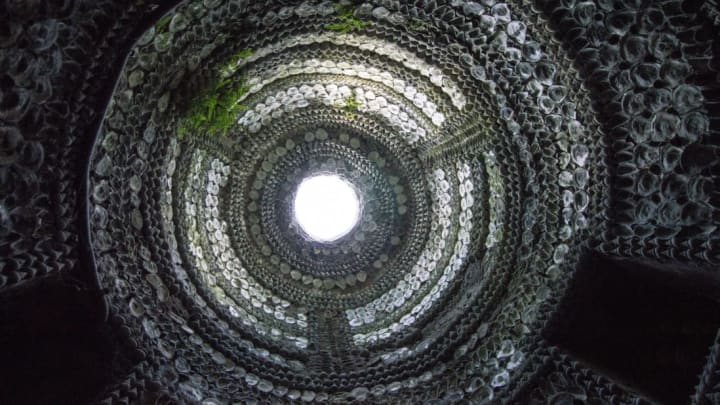The Margate Shell Grotto is one of Kent, England's greatest cultural treasures. Some 4.6 million seashells line the walls of the subterranean passageway in ornate mosaics—but just as interesting as the craftsmanship on display is the mystery behind it. The grotto was discovered accidentally in the 19th century, and to this day no one knows who built it ... or why.
According to most accounts, farmer James Newlove and his son Joshua were digging a duck pond in 1835 when they struck upon the underground cavern. A closer look revealed that they weren't the first people to enter the space, as someone had gathered millions of shells from cockles, whelks, oysters, mussels, and other mollusks and glued them to the walls.

The shells adoring the winding tunnels form intricate and colorful patterns. Some are abstract, while others are laid out in the shapes of animals like birds and reptiles. The space itself covers 2000 square feet, with an altar room at one end of the "serpentine passage" and an underground rotunda at the other.
A few years after stumbling upon the grotto, James Newlove opened it to the public. While the walls could be radio-carbon dated, according to the Grotto's website, "we have been advised by experts in this field that we would need to provide a number of samples (to mitigate against dating a Victorian—or later—repair) and the cost is high." The lack of radio-carbon dating and the fact that the land above it has never been part of a large estate make the origins of the site a mystery. Experts don't know exactly how it was built; analysis of the mortar beneath the shells point to a puzzling "fish-based" substance.

Some people think the masterpiece was built by an ancient civilization. The designs have been described as looking vaguely Egyptian, Roman, Indian, and Phoenician. Others credit groups like the mystics or the Templars. One possible explanation is that the grotto was the project of an eccentric Victorian aristocrat. Follies—decorative structures that serve no practical purpose—were a fashionable way to flaunt wealth during the Regency and Victorian eras. But the question of why someone would build something so elaborate beneath empty pastureland remains unanswered.

The Margate Shell Grotto still welcomes visitors today. For £4.50, or roughly $6.20 USD, you can tour the tunnels and see the nautical artwork up close. You may leave the passage with more questions than answers, but the mystery is part of the appeal.
